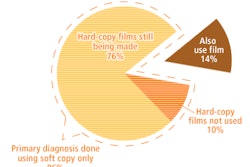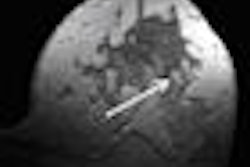COLORADO SPRINGS, CO - Women who have a high risk of developing breast cancer need to be identified. But which healthcare professional has this responsibility? And once a high-risk patient is identified, who's responsible for managing her care?
The topic was very much on the collective minds of breast imaging specialists at the Society of Breast Imaging's (SBI) biannual meeting this week. With the state of the healthcare system in the U.S., there's no clear-cut solution, leaving the issue in the hands of mammographers by default, according to participants at a session on risk assessment.
Primary care physicians, internists, gynecologists, and obstetricians are the most obvious choice for managing high-risk women, as they have the most contact with female patients. However, many aren't utilizing the tools at hand to assess patient risk.
A scheduled mammogram provides an excellent opportunity for breast imagers to take responsibility for risk assessment. And it's important for radiologists to assess risk, because a high-risk patient may need a modified mammography screening schedule.
But how can risk assessment be handled effectively and efficiently without overwhelming a breast imaging practice, especially because time spent making this evaluation is not reimbursed?
Family history
The risk for cancer is not overwhelmingly high for the majority of patients who have a mammogram, according to Robert A. Smith, Ph.D., director of cancer screening at the American Cancer Society (ACS).
Busy practices may consider having patients complete patient history forms in advance. They also may ask patients with access to the Internet to complete some information online. One self-administered tool that Smith recommends to gather family history information is located at www.hhs.gov/familyhistory.
"The presence of a family history of cancer, particularly breast or ovarian cancer, in a first- or second-degree relative on either the maternal or paternal side is the most important first step in identifying the high-risk patient," he said. Important characteristics to evaluate are age at onset of cancer, whether it is bilateral breast cancer, and whether there have been multiple cases in the family. Smith advocates that women of Ashkenazi Jewish descent always be assessed.
Smith suggested that breast specialists use several models to assess the range of risk a patient may have. Together, they can provide a rapid assessment for the radiologist.
The Gail model is popular and easy to use, but it doesn't include paternal family history or age of diagnosis and is designed only for women older than 35. In Smith's opinion, the model is good for identifying if a patient is a candidate for inclusion in a clinical study, but it's less useful for estimating inherited risk with sufficient precision. The BRCAPRO model is quick to fill out, and the Tyrer-Cuzick model is also a simple questionnaire.
Breast density
Breast density is also important to evaluate. Dr. Jennifer Harvey, professor of radiology and division head of breast imaging at the University of Virginia Health System in Charlottesville, noted that 15 large studies have documented at least a moderate association between percentage breast density and breast cancer risk.
Women with dense breasts have a fourfold risk of developing breast cancer, and this characteristic should be evaluated as an independent risk factor. Fifty percent of women in their 40s with dense breast tissue have more than a 50% chance of being diagnosed with breast cancer in their lifetime, and 30% of women between the ages of 70 and 79 have a 75% chance, according to Harvey.
Current risk models do not incorporate breast density as a risk factor. Acknowledging that it's time-consuming to measure tissue density, Harvey commented that software to automate breast density is currently in development; however, rigorous validation testing must be conducted before this much-needed tool becomes commercially available.
Radiologists may need to calculate breast tissue density whether they want to or not. Dr. Carol H. Lee, president of the SBI and a breast imaging specialist at Memorial Sloan-Kettering Cancer Center in New York City, advised that state laws may require radiologists to include breast density measurements in their mammography reports.
She said that an amendment to a proposed bill (S.172) in the Connecticut state legislature requiring the reporting of breast density in every mammography report has a high likelihood of being passed in 2009. Members of the Connecticut Radiological Society have lobbied to have this proposed legislation removed, but without success. Lee expressed concern that if the bill becomes law, it may be replicated in other states, without an understanding of what is being requested and its consequences to mammographers.
"Management of women with high breast density as the primary risk factor is still being defined," Harvey said. "There is little data available on the use of ultrasound or MRI exams. Their lifetime risk is below 20%. In my practice, I recommend to these patients that they have an annual screening mammogram, with additional procedures only if warranted."
Value of ductal lavage
If a show of hands by SBI attendees is indicative of facilities offering mammography in the U.S., anxious patients are continuing to self-present as being high risk due to findings from ductal lavage procedures. Ductal lavage involves collecting and analyzing cells washed out from the breast ducts to determine whether they have precancerous qualities and are likely to develop into cancer in the near future.
Recommended as a way to determine if a woman is at high risk by Dr. Susan Love, a popular author, breast cancer prevention advocate, and breast surgeon, participants in the risk assessment forum said they don't believe that it has any proven diagnostic benefit.
"It sounds like a great idea, but what do you do with the findings? Can you determine where suspicious cells originated?" said Dr. Carl D'Orsi, director of the Breast Imaging Center of Emory Healthcare in Atlanta.
"Try to convince a patient with disturbing ductal lavage results that they are of low or average risk. These patients may take more time to persuade that their concerns are unjustified than providing information to the high-risk patient," one panelist observed. Attendees vocalized their agreement.
How to cope
There is no designated clinical entity in the U.S. responsible for identifying and managing preventive care of patients at high risk for developing breast cancer, according to Smith. He hopes that healthcare reform as envisioned by the Obama administration will address the issue.
"This is an orphaned issue. We are fooling ourselves to say that this is a clinician's duty. Many primary care doctors don't have any expertise to provide intelligent counseling even if they wanted to do so, which many don't. They expect the breast imaging specialist to identify and manage the high-risk patient," he said.
Many breast imaging centers and most radiology departments that offer breast imaging services are unprepared. How many radiology centers can afford to offer genetic counseling? How many patients have coverage for genetic counseling or can afford to pay for it themselves?
The issue that basic genetic counseling may not be reimbursable is a very real one. Should this be a service underwritten by a radiology practice, hospital, or cancer center?
High-risk patients at the University of Virginia Health System are offered genetic counseling free of charge, with the cost absorbed by the cancer center at the hospital, according to Harvey. She acknowledged that this solution isn't financially feasible for many healthcare facilities.
The demands of evaluating and managing high-risk patients add workload to already overloaded breast imaging specialists and centers. Today, no other options exist except to have radiology professionals deal as efficiently as they can with this situation, SBI participants concluded.
By Cynthia E. Keen
AuntMinnie.com staff writer
April 30, 2009
Related Reading
Mammographically dense breasts found in many older women, too, April 27, 2009
Breast cancer risk assessment warranted in older women, March 11, 2009
The comprehensive breast center: Greater than the sum of its parts, September 2, 2008
Bone density may help determine breast cancer risk, July 28, 2008
Family history of breast cancer confers lifetime elevated risk, May 14, 2008
Copyright © 2009 AuntMinnie.com



















